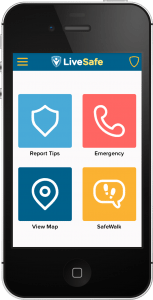
At this year’s US Chamber of Commerce Annual Corporate Citizenship Conference, I facilitated a session on the transforming power of mobile technology to create safer and healthier communities. Panelists included Jenny Abramson, President & CEO of LiveSafe and Jeff Wishnie, Senior Director of Program Technology at MercyCorps. At the time, I could never have imagined that just days after the panel the essential need for some of these tools would hit so close to home.
Early this September, University of Virginia student Hannah Graham tragically disappeared late one night close to campus. As a parent of a University of Virginia student, this story has greatly affected me and my family. Alongside the tragedy of Hannah Graham, a health epidemic has been consuming our world with the ongoing spread of Ebola. With deep sadness and frustration in viewing some of this recent news, I thought often about the incredible and innovative technologies I had learned about just weeks ago in Washington, DC.
Screen shot of LiveSafe mobile applicatioDuring our session, Jenny Abramson discussed LiveSafe’s personal safety application. The app utilizes phone capabilities like geo-location, camera and video to empower users to submit tips during an emergency or crisis and chat with local officials. The app also provides push notifications to its users to inform them of emergency situations close by, even when cell phone networks are down. LiveSafe’s feature SafeWalk allows users to track their location and ask friends or family to virtually walk with them to their destination–ensuring their safe arrival. This particular feature is exceptionally useful for college students.
The usage of the LiveSafe app by peers and community members helps break down the barriers to sharing information about where you are and where you are going. While personal privacy concerns continue to rapidly grow, Abramson and her team’s ultimate goal is to get people to download and use LiveSafe before they face the moment when they need it.
Technology expert Jeff Wishnie, moved beyond the U.S. in our session and described the role of mobile technologies as service delivery “game changers” in the health field. For many people throughout the world the mobile phone is their first individualized communications channel. Through voice and text messaging, health workers can now reach out directly and personally to people in the developing world or countries with fewer resources. By creating a two-way dialogue, experts can address specific concerns and influence behavioral decisions for people in need from across the globe. For example, health workers can remind pregnant women about vital pre- and post-natal care including when to get vaccinations, schedule visits and take required medications through mobile communications. Health care workers can also answer questions immediately, problem solve and communicate directly with other experts.
After discussing some specific innovations in the safety and health fields, the panel offered the following recommendations to companies and nonprofits interested in harnessing mobile technologies for any kind of social change:
1. Avoid “Solutionism” – Don’t lead with the technology tool, before you truly understand the problem. Start with what the problem is, determine possible solutions, and then select the best technology vehicle to get there.
2. Don’t Just Build An App To Have An App – “Because everyone has one” is not a good or strategic reason for your organization to create a mobile app too. Creating this technology must be a strategic and integrated process.
3. Work Across The Sectors – You do not have to be a technology organization to leverage the expertise of mobile technology. Check-out the Re-code Conference, Mobile Active, Mobile Hub and others to find like-minded organizations that can help you with your cause.
As the search continues for answers in the case of Hannah Graham, and the world continues to put an end to Ebola, I can only hope these crises help motivate more organizations to take proactive steps in enhancing their ability to create change. Like the examples from our US Chamber of Commerce session prove, improvements may be as simple as utilizing a technology that most of us carry in our back pockets each day.

